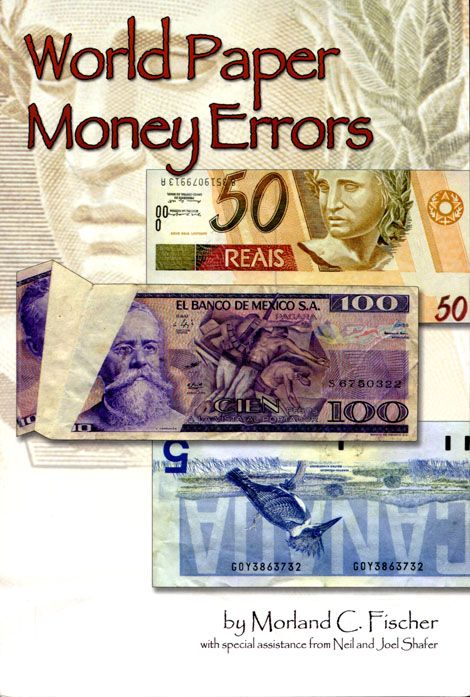
250 pages, soft cover, 230 x 150 mm, color illustrations, English, published by Zyrus Press Publishing, ISBN 978-1-933990-25-5
Reviewed by Owen W. Linzmayer
While there are several catalogs covering United States paper money errors, this book is the first attempt at a systematic approach to describing, documenting, and pricing errors on world banknotes. As such, it’s an important new addition to the world’s numismatics knowledge base, but it suffers from some shortcomings I hope will be addressed in future editions.
Author Morland C. Fischer does a very good job of explaining the various types of errors found on banknotes and has distilled them down to an eight-point FEN (Foreign Error Note) ranking system in which higher numbers correspond to more significant errors. Reasonable people might disagree over whether a missing overprint is more dramatic an error than an inverted back (FEN 4 and 7, respectively), but the codification of the taxonomy of errors is a welcome improvement to a subjective field of study.
The bulk of the book is devoted to illustrating the various error types, each broken into their own chapters. I found the introductory explanations of how specific types of errors happen in the production process particularly interesting. The book has color illustrations throughout, usually with the front and back of the error note at 50% actual size, along with a non-error note for comparison. This allows you to see the magnitude of the error and appreciate the artwork and intended design of the reference note, although some illustrations would have benefited by close-ups or annotations to highlight the affected areas of the note. There are lots of examples from many different countries and time periods, which is good overall, but it’s overkill for some types of errors, such as missing serial numbers, which are easy to understand without repetitive illustrations.
Personally, I would have liked to see more plate errors—also known as engraving errors—because I find man-made errors more intriguing than machine mistakes. As a writer and editor myself, I’m amused by the fact that central banks sometimes fail to catch embarrassing typos until after printing and issuing millions of notes into circulation. Alas, there are only a dozen such errors discussed. Entirely lacking are any examples of errors in security features, such as when a thread intended for one note appears in another, or the wrong watermark is used.
Anyone who has contemplated buying an error note will do well to first read the chapter on “pseudo” errors. At first glance these appear to be errors, but may have been intentionally created by unscrupulous collectors/dealers by miscutting individual notes from sheets or using chemicals to alter notes, for example. Sometimes they aren’t errors at all, but rather printers’ waste, proof notes, or remainders. Buyer beware.
Ironically, the author is not immune to making errors of his own. For example, he mistakes the front and back of Ukraine’s 20-hryvan note of 1992 (Pick 107), includes a 1,000-shilling fantasy note from Somaliland without mentioning its dubious origin, and the last few pages of the book are incorrectly set in fonts of varying size, resulting in a jumbled appearance. However these are all minor quibbles; for the most part the content is solid and unassailable.
My main complaint with this book is that author tries too hard to make the case that world error notes are undervalued. He provides a number of possible explanations for the disparity in prices between comparable errors on US and foreign notes, yet ignores what might be the most obvious explanation of all: differences in the values of the corresponding non-error notes. For example, he laments that a foldover error on a United States 10-dollar note dated 1969C (Pick 451d) is worth $1,000 – 2,000 whereas a similar printing error on a Mexican 500-peso note (Pick 69) is valued at $200 – 300. But when you consider that the SCWPM lists non-error examples of the former at four times the value of the latter, the price disparity between the errors doesn’t seem so significant nor unwarranted.
Judging by the passion with which he approaches his subject, it is apparent that the author loves error notes, but his insistence that world error notes are “undervalued,” with “considerable upside potential,” and “could be ready to explode,” comes across as a hard sell by someone with an agenda. I found cause for pause when reading “In some instances, a price may appear to be unusually high. However, prices were chosen to indicate what should be [emphasis mine] the fair market value…Moreover, the assigned price ranges reflect an extrapolation of expected prices over a period of five years from publication.” Pricing non-error world notes is fraught with difficulties (fluctuations in currency exchange rates and differences in foreign/domestic demand for a country’s own notes, for example) which are only compounded when considering far less common—sometimes even unique—error notes and trying to guess what they should be worth far into the future. The book would have greater credibility if it merely reported current free market prices and suggested reasonable premiums a collector might expect to pay for different types of errors.
World Paper Money Errors carries a list price of US$34.95 and can be ordered directly from Zyrus Press Publishing, P.O. Box 17810, Irvine, CA 92623. (888) 622-7823. www.zyruspress.com or purchased from Amazon at a significant discount.
